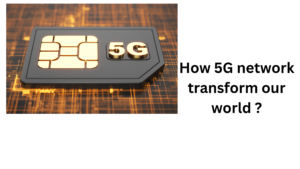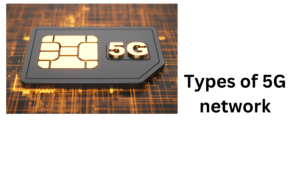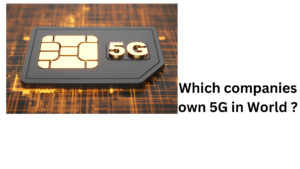5G
The next generation of wireless technology is upon us, and it’s called 5G. This new standard promises faster speeds, lower latency, and more capacity than ever before. But what does that mean for the average person? And how will it change the way we use technology?

5G
How 5G work ?
The fifth generation mobile network, or 5 G for short, is the next big leap in wireless technology. 5 G promises faster speeds, lower latency, and more reliability than ever before. Here’s a look at how 5 G will work and what it will mean for you.
5 G networks will use a combination of technologies to achieve their high speeds and low latency. One of these technologies is called millimeter wave (mmWave). MmWave signals are higher frequency than the signals used by current cellular networks. They can carry more data but don’t travel as far and can be easily block by buildings or other obstacles.
Another key technology for 5G is called beamforming. Beamforming allows antennas to focus their signal in a specific direction, rather than broadcasting in all directions like current cellular networks. This helps reduce interference and makes the signal stronger.
To put it all together, 5G networks will use multiple small cell sites that utilize mmWave signals. And beamforming to provide high-speed coverage over a large area. The result will be a wireless network that is much faster and more reliable than anything we have today.

How 5G work ?
How 5G network transform our world ?
5 G is not simply an evolutionary upgrade to 4G—it’s a foundational new technology that will revolutionize how we connect and interact with the world around us. It will enable new use cases and experiences that we can only begin to imagine, opening up a world of possibilities for individuals, businesses, and society as a whole.
5 G will have a transformative impact on our economy and society, enabling new industries and services and creating millions of jobs. It will enable us to do things that weren’t possible before, like remotely operating heavy machinery or delivering medical care to remote areas. And it will help us solve some of the biggest challenges we face as a society, from climate change to congestion.
5 G will be critical to realizing the full potential of the Internet of Things (IoT). Which is estimated to include more than 50 billion connected devices by 2030. With 5 G, these devices will be able to communicate with each other in real time, enabling new applications and services that we can’t even imagine today.
The deployment of 5G networks is already underway, with commercial networks expected to be up and running in 2020. But the full benefits of 5 G won’t be realized until it’s integrated into other technologies like artificial intelligence (AI) and virtual reality (VR). As 5G evolves, it will create opportunities for even more transformative technologies and applications that we can only begin to imagine today.

How 5G network transform our world ?
Types of 5G network
The next generation of mobile networks, 5 G, is here. But what is a 5G network?
A 5 G network is a wireless network that uses the latest generation of mobile technology. It offers faster speeds and lower latency than previous generations of mobile networks.
There are two types of 5G networks: mmWave and sub-6 GHz.
mmWave: This type of 5 G network uses high-frequency waves to transmit data. It offers speeds up to 10 times faster than 4G LTE, but has shorter range and can be block by obstacles like walls or buildings.
sub-6 GHz: This type of 5 G network uses lower-frequency waves than mmWave. It offers slower speeds than mmWave, but has better range and can penetrate obstacles like walls or buildings.

Types of 5G network
Benefits of 5G
5 G will provide faster download and upload speeds, lower latency, and more reliability. 5G will also allow for more devices to be connect at the same time without affecting performance.

Benefits of 5G
Disadvantages of 5G network
5G technology is not yet widely available, which means that users may have to wait a while before they can take advantage of its benefits. In addition, 5 G service is likely to be more expensive than current 4G service, since it requires the purchase of new equipment and infrastructure. Additionally, 5 G technology has not been fully tested, so there may be unforeseen problems with its rollout.

Disadvantages
Is 5G better then Wifi ?
There are many benefits of 5 G over WiFi, including speed, capacity, and latency. 5G is able to achieve speeds up to 10 Gbps, while WiFi maxes out at around 1 Gbps. This means that 5G can download an HD movie in seconds, while it would take minutes on WiFi. In addition, 5 G has a much higher capacity than WiFi, meaning that more devices can be connected to the network at once without experiencing any slowdown. Finally, 5 G has significantly lower latency than WiFi, meaning that there is less lag when using 5G-enabled devices.

Is 5G better then Wifi ?
4G vs 5G
4G vs 5G
The world is on the verge of a new era of mobile technology. The battle lines are being drawn between two camps: those who support the current 4G LTE standard, and those who are backing the new 5 G standard. So, what’s the difference between these two technologies, and why does it matter which one becomes the dominant force in the market?
4G LTE is currently the most widely used mobile data standard, offering speeds that are significantly faster than 3G. However, it is not without its limitations – namely, capacity and latency issues. 5 G promises to address these problems with faster speeds and lower latency, making it a more viable option for applications that require real-time data or high bandwidth.
One of the key benefits of 5 G is its ability to support a large number of devices simultaneously without compromising on speed or quality. This is thanks to its use of millimeter waves (MMW). Which have shorter wavelengths .It can carry more data than traditional radio waves. MMW also allows for smaller cell sizes, meaning that network operators can deploy more cells per given area.
However, there are some drawbacks to using MMW. One is that they cannot penetrate walls or other obstacles, so coverage may be patchy in indoor environments. Another is that MMW signals are more susceptible to interference from weather conditions like rain or snow.

4G vs 5G
Which companies own 5G in World ?
There are many different companies that own 5G around the world. In the United States, Verizon owns a large portion of the 5 G network. AT&T also has a significant amount of 5G coverage. T-Mobile is another carrier with a lot of 5G coverage. In Europe, Vodafone has a strong presence in the 5G market. Deutsche Telekom is also a major player in the European 5G market.

Which companies own 5G in World ?
AT&T 5G
AT&T 5 G is the next generation of wireless network technology, and it promises to revolutionize the way we connect to the internet. With speeds up to 10 times faster than current 4G LTE networks, AT&T 5 G will allow you to download movies, stream video, and browse the web at lightning-fast speeds. And because it uses a new type of spectrum, it will be able to handle more data than ever before. Making it perfect for future applications like virtual reality and augmented reality.

AT&T 5G
Can we convert 4G to 5G ?
4G is the current standard for cellular data speeds, while 5 G is the next generation. While 4G is very fast, 5 G promises to be even faster. So, can we convert 4G to 5G?
The answer is no, at least not yet. 5G networks are not compatible with 4G devices and vice versa. In order to take advantage of 5G speeds, you’ll need a 5G-compatible device. However, there are some ways to get around this.
One option is to use a 5G hotspot. A hotspot is a small device that create a Wi-Fi network wherever it’s place. You can connect your 4G device to the hotspot and receive 5G speeds.
Another option is to wait for your carrier to upgrade its network. Once carriers flipping the switch on their 5Gs networks, your 4g device should be able to connect and receive the faster speeds (providing it’s in an area with good coverage).

Can we convert 4G to 5G ?
For more knowledge about technology visit this link:


